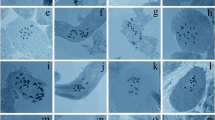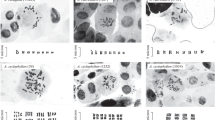Abstract
The present study reports the chromosome numbers and karyotypes of six Aspidistra species from China, of which four species from Guangxi are described for the first time, i.e., A. bicolor with 2n = 36 = 20m + 2sm + 12st + 2t, A. cerina with 2n = 36 = 20m + 2sm + 14st, A. obliquipeltata with 2n = 38 = 20m + 6sm + 12st and A. connata with 2n = 38 = 20m + 6sm + 12st. A. papillata with 2n = 38 = 22m + 2sm + 14st, is a new record to Guizhou, and first report for cytological data. The karyotype of A. retusa from Guangxi, formulated as 2n = 36 = 14m + 10sm + 12st, is different from the previous report for the chromosome pair VIII, XI and XII pairs that depict their submedian karymorpholgy without any satellites . Further, the intra- and interchromosomal asymmetry indices of the karyotypes of the above species are also presented that are helpful in elucidating the karyotype evolution in Aspidistra.



Similar content being viewed by others
References
Gao Q, Huang YS, Meng T. Aspidistra bicolor H. J. Tillich, a newly recorded species of Aspidistra (Ruscaceae) from China. Acta Bot Boreal-Occid Sin. 2012;32:1566–1567.
Gao Q, Liu Y. Aspidistra hezhouensis (Ruscaceae s.l.), a new species from Guangxi, China. J Syst Evol. 2011;49:506.
Gao Q, Liu Y. Karyomorphology of Aspidistra grandiflora from Indonesia. Nucleus. 2012;55:139–141.
Hou MF, Liu Y, Kono Y, Peng CI. Aspidistra daxinensis (Ruscaceae), a new species from limestone areas in Guangxi, China. Bot Stud. 2009;50:371–378.
Levan A, Fredga K, Sandberg AA. Nomenclature for centromeric position of chromosomes. Hereditas. 1964;52:210–220.
Li GZ. The genus Aspidistra. Nanning: Guangxi Science & Technology Publishing House; 2004.
Phonsena P, De Wild WJJO. The genus Aspidistra Ker-Gawl. (Asparagaceae/Ruscaceae) in Thailand. Thai Bull (Bot). 2010;38:48–58.
Qiao Q, Ma YP, Tian W. Karyotype asymmetry of Aspidistra (Convallarieae, Ruscaceae). Acta Bot Yunnan. 2008;30:565–569.
Romero Zarco C. A new method for estimating kayotype asymmetry. Taxon. 1986;35:526–530.
Tillich HJ. An updated and improved determination key for Aspidistra Ker-Gawl. (Ruscaceae, Monocotyledons). Feddes Repert. 2008;119:449–462.
Wang RX, Li GZ, Lang KY, Wei YG, Liu Y, Zhang XH. Cytotaxonomy of the genus Aspidistra from China I. Karyotypes of four species endemic to Guangxi. Guihaia. 1999;19:229–232.
Xu WB, Huang YS, Ye XX, Liu Y. Aspidistra connata H. J. Tillich, a newly recorded species of Aspidistra (Ruscaceae) from China. Guihaia. 2012;137:613–615.
Acknowledgments
This study was supported by the Science Research Foundation of Guangxi Institute of Botany (Grant. No. 10005), Western Light Talent Culture Project 2013-165, National Natural Science Foundation of China (Grant. No. 31200160) and National Basic Research Development Program of the Ministry of Science and Technology of China (Grant. No. 2013FY112100).
Author information
Authors and Affiliations
Corresponding author
Rights and permissions
About this article
Cite this article
Meng, T., Gao, Q. Karyomorphology of six species of the genus Aspidistra Ker-Gawl. (Fam. Asparagaceae s.l.) from China. Nucleus 57, 143–147 (2014). https://doi.org/10.1007/s13237-014-0117-9
Received:
Published:
Issue Date:
DOI: https://doi.org/10.1007/s13237-014-0117-9




